| Srl | Item |
| 1 |
ID:
192285
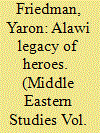

|
|
|
|
|
| Summary/Abstract |
The aim of this article is to provide evidence that the legacy of the Nu?ayr?- ?Alaw? Heroes has continued from medieval times to the present, where we can see it in the ongoing civil war in Syria
|
|
|
|
|
|
|
|
|
|
|
|
|
|
|
|
| 2 |
ID:
157913
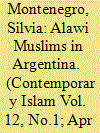

|
|
|
|
|
| Summary/Abstract |
This article examines contemporary aspects of the identity construction of the ‘Alawi diaspora in Argentina. In the local context, the preservation of ‘Alawi singularity has so far been a key element in the group’s identity. The strategies for integration as legitimate Muslims in the wider Islam and the closeness to Shi’ism are relatively independent of how these processes took place in the homeland. I first describe the geography of the diaspora in Argentina, comprising the spaces and institutions where descendants settled all over the country. I analyze the factors that helped keep the nodes connected and I will demonstrate that these constitute a center/periphery logic for communities concerning the alleged degrees of preservation of the culture of origin they symbolize. I will try to show that ‘Alawis integrated into the diversity of Islam in Argentina while preserving their sectarian borders and, at the same time, stressing an “Arab” identity. I argue that these strategies should be understood in the local arena of an intra-Islamic pluralism that constitutes Muslim presence in Argentina, where the dynamics of sectarianisms assume idiosyncratic characteristics. Finally, I will show institutional closeness to Shi’ism as a recent development, promoted by the common political stance of both groups on the conflict in Syria. We will see that this closeness does not imply the dissolution of doctrinal boundaries between Shi’is and ‘Alawis and that it involves a redefinition of the diaspora in terms of increasingly claiming a Syrian national origin.
|
|
|
|
|
|
|
|
|
|
|
|
|
|
|
|
| 3 |
ID:
177661
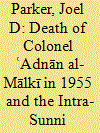

|
|
|
|
|
| Summary/Abstract |
This article reconsiders the simple minority-majority dichotomy that surrounded the death of Colonel ʿAdnān al-Mālkī who was a Sunni killed by an ʿAlawi in 1955. Nevertheless, it was not the ʿAlawi minority, or other non-Sunni minorities that drove the subsequent power struggle that arose in Syria. Rather what occurred was a battle for control of the identity, direction, and economic organization of the young state contested by two alternative networks of Sunni elites, namely ʿulemaʾ (religious-scholarly) families, and ʿaskerī (military-administrative) families, both of whose social origins can be found in Ottoman history. This study argues that al-Mālkī’s assassination temporarily weakened the Syrian ʿulemaʾ families’ position in the civil-military balance that undergirded Syrian society and allowed the ʿaskerī class to gain the initiative. Such a change is evidenced by Damascus’s turn toward the Soviet Union for arms as well as other state-building materials. The inability of these two competing internal networks to resolve their differences throughout the Cold War resulted in political dysfunction throughout the Cold War era. The ascent of Gamal ʿAbd al-Nasser to power with the creation of the United Arab Republic in 1958 proved a temporary abeyance in this struggle, but a final resolution came only much later when Hafez al-Assad became leader in 1970.
|
|
|
|
|
|
|
|
|
|
|
|
|
|
|
|
| 4 |
ID:
095481
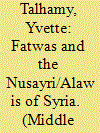

|
|
|
|
|
| Publication |
2010.
|
| Summary/Abstract |
There were five fatwas prior to the twentieth century which were issued by Sunni scholars. Some of these fatwas were specifically against the Nusayris/Alawis while others were against all the extreme Shi'ite creeds including the Nusayris. The first three fatwas were issued during the fourteenth century, during the period of Mamluk rule. They were issued by Shaykh al-Islam Taqi al-Din ibn Taymiyya, and were specifically directed against the Nusayris. The fourth fatwa was issued during the first years of the Ottoman rule over the region of Syria and was against all the extreme Shi'ite creeds. The fifth and last fatwa was issued by a local Shaykh of Latakia specifically against the Nusayris. Those fatwas viewed the Nusayris as heretics outside Islam. During the twentieth century, after the collapse of the Ottoman Empire, the region witnessed the ascendance of 'Pan Arabism', and it was during this period that the Nusayris, known now as Alawis, received a fatwa from the prominent Sunni mufti Hajj Amin al-Husayni recognizing them as part of the Muslim community, which helped them integrate into the Arab world and in Syria. In 1970, the Alawis, under the leadership of the Alawi Hafiz al-Asad, became the rulers of Syria. During the 1970s the Alawis were granted two additional fatwas, this time from prominent Shi'ite scholars recognizing them as part of the Shi'ite creed. All these fatwas had an enormous effect on shaping the history of the Nusayris.
|
|
|
|
|
|
|
|
|
|
|
|
|
|
|
|
| 5 |
ID:
112116
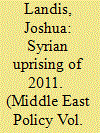

|
|
|